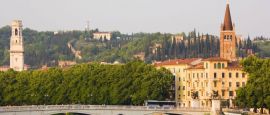Built in the 1120s and 30s, this is one of the finest examples of Romanesque architecture in Italy. It has an imposing façade and an impressive bell tower that is mentioned in the Divine Comedy by Dante Alighieri. Inside are fresco-clad walls and a crypt with the remains of Saint Zeno. Part of its fame comes from the tradition that its crypt was the place of the marriage of Shakespeare's Romeo and Juliet.
Things to see in Verona
Tourist offices
Address: Piazza Bra, via degli Alpini 9
, Verona, 37121, Italy
Tel: +39 45 806 8680.
Opening Hours:Mon-Sat 0900–1800, Sun 1000-1600. www.tourism.verona.it
IAT Verona is a small and friendly tourist office selling English language guides and offering a range of free maps, including a shopping map and a guide with information about all the main historical sites. A second tourist office can be found at Verona Porta Nuova railway station, Piazza XXV.
The VeronaCard (www.veronacard.it) gives free or discounted access to museums, churches and other attractions in Verona. Visitors can buy either a one- or a three-day pass. The card is sold at museums, churches and tourist information offices.
This 14th-century castle belonged to Verona's medieval rulers, the della Scala family, and was only converted from a military fortress in 1925. It still houses weapons and jewellery, but its most interesting treasures are works by Pisanello, Veronese and Tintoretto alongside a selection of medieval frescoes and sculptures.
Dominated by the impressive walls of the Arena, and the stylish neoclassical facade of the Palazzo Municipale, this central piazza has been at the centre of Veronese life for centuries. Rimmed by cafes and restaurants in pastel-coloured buildings, it’s an ideal spot for an aperitivo and a little Veronese people-watching.
While the Capulet family did indeed live in Verona, it is doubtful that they ever lived in Casa Giulietta (Juliet's House), and the balcony was only erected in the 1920s to satisfy visitors. There is a statue of Juliet in the courtyard. The Montague family actually lived at Casa Romeo (Romeo's house), found along arche Scaligere 4. It is not open to the public.
One of the most beautiful Renaissance gardens in Italy, the Giardino Giusti behind the palace of the same name is a spacious estate featuring flowers, fountains, statues, a cypress-lined avenue and one of Europe's oldest labyrinths. It dates from the late 16th century, but has been renovated many times since.
Dating from 1st century BC, the Roman Theatre has a magnificent hillside location north of the Old Town. After centuries of disuse it was recovered in the 19th century, and has been used for theatre and ballet productions. The Archaeological Museum, located in a former medieval Jesuit convent, is currently closed for renovation.
Climb the 84m-high (276ft) medieval Torre dei Lamberti (Lamberti Tower) for spectacular views across Verona. A lift will take you most of the way, but the last few storeys must be done under your own puff. Tickets also allow entry to the adjoining Galleria d'Arte Moderna (Gallery of Modern Art) Achille Forti, home to a fascinating collection of regional contemporary art from the 19th century to the present day.
The Arena in Verona is the largest Roman amphitheatre in northern Italy, with a capacity of 25,000 people. It was constructed early in the 1st century AD, and has been the site of gladiatorial combat, public executions and, more recently, concerts and opera performances. It also hosts the city's famous opera festival every summer.
Constructed between 1290 and 1481, Verona’s largest church is also a repository for some of the city’s best art. The bare exterior disguises an interior rich in frescoes. Look out for Pisanello’s storybook fresco of St George Setting out to Free the Princess from the Dragon.
Natural history buffs will lose hours at the Museo di Storia Naturale, where 16 welcoming rooms brim with historic and scientific finds across botany, geology, pre-history and zoology sections. The museum is housed in the grand Palazzo Pompei, once home to the wealthy Lavezzola family, which was built between 1530 and 1550.
Do you have any Feedback about this page?
© 2025 Columbus Travel Media Ltd. All rights reserved. No part of this site may be reproduced without our written permission, click here for information on Columbus Content Solutions.








 You know where
You know where